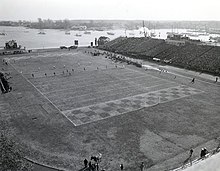 | |
 | |
| Full name | Robert Means Thompson Stadium |
|---|---|
| Location | United States Naval Academy Annapolis, Maryland |
| Coordinates | 38°58′43″N 76°28′59″W / 38.9786°N 76.483°W |
| Owner | United States Naval Academy |
| Operator | United States Naval Academy |
| Capacity | 12,000 |
| Surface | Natural grass |
| Construction | |
| Built | 1914 |
| Opened | 1914 |
| Demolished | early 1980s (~42 years ago) |
| Tenants | |
| Navy Midshipmen (NCAA) (1924–1958) | |
Robert Means Thompson Stadium was an American football stadium in the eastern United States, located on the campus of the United States Naval Academy in Annapolis, Maryland. Constructed in 1914, it was the home stadium of the Navy Midshipmen from 1924 through 1958, and was named after alumnus Robert Means Thompson (1849–1930). He created or led several athletically-based organizations at the academy until his death. It was succeeded by the larger Navy–Marine Corps Memorial Stadium in 1959,[2] the current venue of Navy football.
Before its conversion to a football stadium, the Thompson Stadium site was an unused area on the south end campus, near the water of Annapolis Harbor. Work on the stadium began in 1914, and was finished later the same year. The seating capacity was 12,000,[3] and it underwent few changes during its entire use. It was surrounded by a regulation quarter-mile (402 m) running track, and only had a single seating section, along the southwest sideline. The field had a northwest-southeast alignment, at an elevation slightly above sea level.
During the 1940s, the Naval Academy began to look for options to construct a new, larger football stadium. The school's directors collected money to build the stadium, for which much support was given by the public, due to the lack of seating at Thompson Stadium. Construction on the new stadium began in 1958 and it opened in September 1959.[2] Use of Thompson Stadium ended for varsity games, but it remained until the early 1980s, when it was replaced by Lejeune Hall,[4] the venue for USNA water sports.
- ^ "Navy's 14-0 win adds final touch to unusual service clash". Reading Eagle. (Pennsylvania). Associated Press. November 29, 1942. p. 13.
- ^ a b "Navy is winner in new stadium". Spokesman-Review. (Spokane, Washington). Associated Press. September 27, 1959. p. 3, sports.
- ^ "Contract is let for Navy Stadium". Spokane Daily Chronicle. (Washington). November 15, 1922. p. 14.
- ^ "1972 Reef Points map". USNA Parents Club of North Texas. October 9, 2010. Archived from the original on November 14, 2011. Retrieved August 5, 2012.

